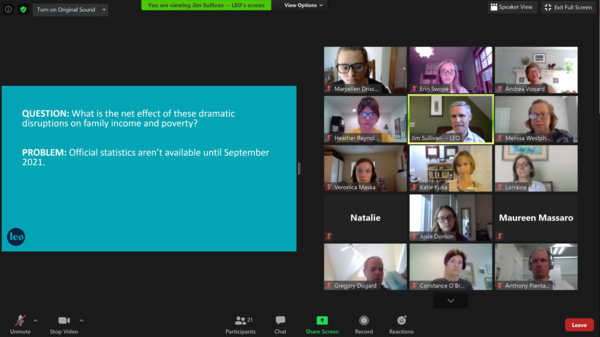When the COVID-19 lockdowns started in March, economic activity declined. A lot. At one point, the U.S. saw around six million unemployment claims a week—indicating the largest one-month decline in employment on record.
In response to these economic hardships, the U.S. government passed the CARES Act, an unprecedented economic stimulus bill that transferred around $250 billion directly into the pockets of Americans. Social service agencies and donors also stepped up to support families.
In such times, LEO managing director Heather Reynolds said, “LEO is needed more than ever” to understand what interventions are most effective at helping families stay afloat.

So, was the CARES Act effective at keeping families from falling into poverty? This question is crucial to understand as Congress prepares to look at a new stimulus package. But official poverty rates for this year won’t be available until September 2021.
LEO co-founder Jim Sullivan, along with co-authors Jeehoon Han and Bruce Meyer from the University of Chicago, sought to address this issue with a recently published paper, Income and Poverty in the COVID-19 Pandemic. Their results were surprising. Using monthly data on family income from the U.S. Census Bureau, the researchers can track poverty statistics on a near-real-time basis. They found that the overall poverty rate decreased by 1.5 percentage points from January to June of this year.
Jim presented his research to a group of LEO partners and supporters at a virtual “coffee talk” in July. He said this research is valuable to both the government and social service organizations. For the government, it can help inform future policy decisions, such as how any future stimulus payments should be structured.
Social service organizations can also use this research to gauge the level of need for their services in the communities they serve. Jim emphasized the real need for these organizations to stand in the gap for families experiencing a loss of income.
“Families are facing great uncertainty,” Jim said. “Most low-income families don’t have the money to cover one months’ lost income, let alone losing their income indefinitely.”
Still, the CARES Act did have a positive impact on vulnerable individuals’ incomes overall. While the economic stimulus payments helped, the expansion of unemployment insurance was one of the largest contributors to the decrease in the poverty rate. In fact, a family of four earning 75% or more of the federal poverty line could have, with this aid, earned more per month than they had before the pandemic, pulling them above the poverty line.
This research also uncovered differences in how the poverty rate changed for different groups. For example, the decrease in poverty was greater in states that implemented stay-at-home orders later (approximate decrease in poverty rate of 2.5%) than states that implemented them earlier (approximate decrease in poverty rate of 1%). Poverty rates also fell more for Blacks and other minorities than it did for white households.
While it’s good news that poverty overall fell as a result of the stimulus, other issues that affect low-income families, such as food insecurity, are still present.
“Income isn’t a comprehensive measure of economic well-being. Compared to the months prior, we’ve seen a sharp rise in reports of concerns about food insecurity. Significant concern about the ability to pay rent. So this is real,” Jim told the audience. “The last thing I want the takeaway from this research to be is that everything is good. That we don’t need to worry about this. ”
The research team will continue to update its poverty rate results as new data becomes available each month.
“One of the things that has happened as a result of the pandemic is that the federal government and many research shops have realized this pressing need for real-time information. So there has been a launch of many surveys to try and capture what is happening to families during this period. There are other surveys asking about food insecurity, about if families are struggling to pay rent,” Jim said.
While Jim’s research results are encouraging, they are only the beginning of answering the question of whether or not the federal government’s stimulus actions and other interventions work, and what to do in the future.
As Jim said, “The ‘what you do about it’ is a much harder part of the question.”